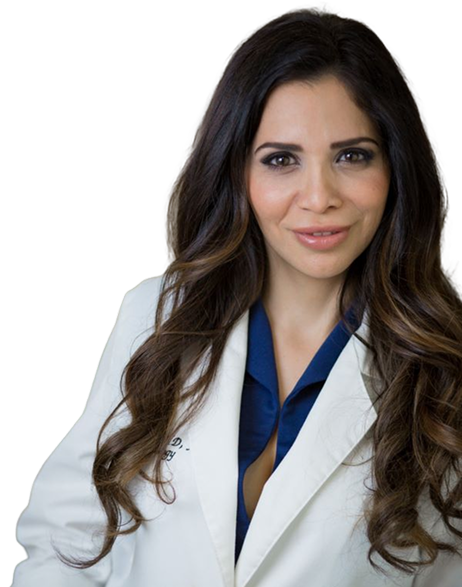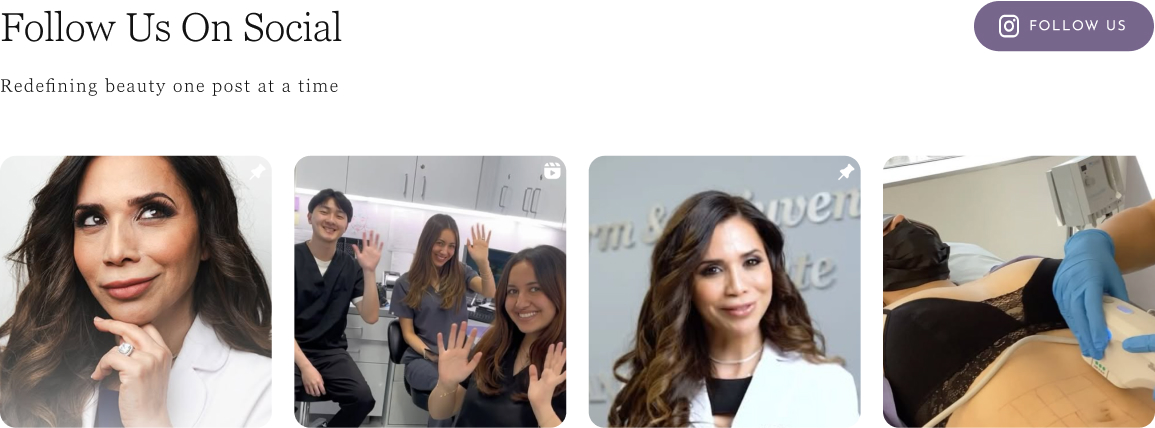Contents
- 1 To begin your journey toward glowy, radiant skin, call (310) 526-8301, or inquire about one of our many treatments using our contact form. We cannot wait to teach you more about our personalized approaches that will cater to the results you want to achieve.
- 2 Watch & Learn
- 3 What is Sun Damage?
- 4 Meet Dr. Kormeili
- 5 How Can I Reverse Sun-Damaged Skin?
- 6 Aftercare Instructions
- 7 Personal Consultation
- 8 Cost of Sun Damage Treatment in Santa Monica
- 9 Why Our Patient Are Saying
- 10 Reach Out For More Information
Sun damage reversal is the process of healing the skin with minimally invasive treatments that increase collagen and elastin production, providing a smoother, clearer, and more hydrated appearance. Those with sun damage may have deeper wrinkles and folds, rough, flaking skin, discolorations, and spider veins. By simply triggering the skin’s natural regenerative abilities, rejuvenation experts can help patients attain the skin of their youth.
To begin your journey toward glowy, radiant skin, call (310) 526-8301, or inquire about one of our many treatments using our contact form. We cannot wait to teach you more about our personalized approaches that will cater to the results you want to achieve.
At Derm & Rejuvenation Institute in Santa Monica, CA, our experts will address your individual skin needs by addressing the root cause of your concerns. Our board-certified dermatologist, Dr. Tanya Kormeili understands the intricacies of different types of sun damage and how to incorporate state-of-the-art treatments to target specific issues. She not only wants you to feel amazing and confident in your skin, but she stands behind effective treatments that nurture your overall skin health that will last throughout the years. Sun damage can cause a drastic change to your overall complexion and make you appear older or more tired than you truly are, but you can make that change with a variety of minimally and non-invasive options at our practice.
Watch to learn more about related hand rejuvenation procedures Erase Redness & Rosacea with VBeam Laser!Watch & Learn



What is Sun Damage?
Sun damage- also called photoaging- can present itself in a variety of different ways. Usually, one instance of experiencing a sunburn will not result in any permanent drastic changes, but the accumulation of damage over time takes its toll on the skin. UV rays from the sun can interfere with DNA, causing abnormalities in the way the skin regenerates new cells. Because of these changes, UV rays can increase the likelihood of developing skin cancer. More commonly, photoaging affects the quality and quantity of collagen and elastin fibers in particular, resulting in more lax skin and apparent wrinkles. In severe cases of photoaging, people can develop a condition called solar elastosis in which the skin wrinkles, but it also thickens and develops a yellow hue. In more minor instances, people may just appear older than they truly are. The sun can also trigger a wide range of blemishes; everything from harmless freckles to very dark melasma and vascular lesions can develop. Understanding the type of sun damage you have is critical for Dr. Kormeili to prescribe the right treatment:
- Wrinkles are a normal part of aging and repetitive facial expressions, but if they appear deeper and coarser, they may be due to UV damage. (1) Common popular treatments like Botox and dermal fillers may not resolve these wrinkles.
- Hyperpigmentation usually develops from an overproduction of melanin, the pigment that determines skin color. Sun exposure can overstimulate the melanin-producing cells- called melanocytes– and result in abnormal liver spots and unwanted freckles. For some, hormonal fluctuations and genetic predispositions can trigger melasma, a condition characterized by blotchy patches of darker skin.
- Vascular lesions from sun exposure come from the degradation of connective proteins surrounding small blood vessels within the skin, causing spider veins. UV rays are also a common trigger for rosacea, especially within the face.
Meet Dr. Kormeili
The first step in neck rejuvenation is medical evaluation and treatment and designing your individualized plan. Please feel free to contact Dr. Tanya Kormeili’s Santa Monica office if you are concerned about Botox for neck rejuvenation. We serve patients in Santa Monica, Brentwood, Malibu, Culver City, Los Angeles, Beverly Hills, & surrounding areas in California.
See More
How Can I Reverse Sun-Damaged Skin?
Sun damage can manifest in various forms, including hyperpigmentation, sunspots, and premature aging. Depending on the extent of your sun damage, one or more of these treatments can produce incredible results:
Chemical Peels
Chemical peels are acid-based solutions that Dr. Kormeili can apply to your skin to help it shed dead skin cells and boost collagen production, restoring a brighter, even-toned appearance. These treatments are not only well-suited for the face, but she can also apply them to other areas that have suffered the effects of UV damage, such as the chest, neck, and hands. Each type of solution is designed to penetrate at a specific depth within the epidermis (topmost layer) or the dermis layer beneath it.
Dr. Kormeili can custom-tailor various acids for individual skin types and conditions. Whether you’re seeking a gentle peel for subtle improvements or a more intensive treatment for significant rejuvenation, we have the expertise and knowledge to cater to your need
- The TCA peel offers a multitude of benefits for skin rejuvenation and sun damage reversal. It involves the application of trichloroacetic acid (TCA) to the skin’s surface, resulting in controlled exfoliation and the removal of damaged outer layers. Dr. Kormeili can customize a TCA peel to contain anywhere from 10 to 35% TCA, so these peels can range from lighter to medium. Depending on the strength, you can expect your skin to peel for at least 3 days as the dermis works to repair with clearer, fresher layers.
- The beta lift peel is a light peel made with fruit-based beta hydroxy acids (BHAs) that serve to treat oily skin, acne, and mild signs of sun damage. These gentler treatments are great for those who want a natural glow without the worry of excessive skin peeling. If you are new to trying chemical peels, a beta lift can be a great start to subtle rejuvenation. Since they are not as robust as other peels, patients can safely undergo a BHA peel session every 4 to 8 weeks. They are also safe for all skin types and will not affect your natural pigmentation. (2)
- The VI peel is a medium peel with a blend of acids to remove the epidermis and the upper dermis layers. These usually include lower concentrations of salicylic acid, TCA, retinoic acid, and some phenol. They also tend to contain vitamin C, a vital antioxidant that protects the skin against environmental toxins. Since it is medium-strength, it is more equipped to handle fine lines and wrinkles, melasma, and deeper pigmented lesions that form within the dermis layer. Dr. Kormeili can apply a certain percentage of acid to make the treatment stronger or weaker, depending on your needs. VI peels are not suitable for regular use like BHA peels, but they will provide you with longer-lasting and more comprehensive results that will leave your skin feeling firmer and more radiant after healing.
- The Jessner peel is another medium-strength peel that usually contains acid ingredients such as salicylic acid, resorcinol, and lactic acid. Formulations contain TCA concentrations of around 35%, so these tend to be stronger than VI peels. (3)
Laser Treatments
Lasers tend to produce more targeted results within a quicker time frame. Each unit of light a laser emits is measured as a specific wavelength designed to correct certain aesthetic issues and accommodate different skin tones.
- IPL (intense pulsed light) therapy addresses both brown and red discolorations. During an IPL treatment, high-intensity pulses of light are delivered to the targeted areas of the skin. This non-invasive procedure specifically targets pigmented cells, such as melanin, while leaving the surrounding healthy tissue untouched. The light energy is absorbed by the melanin, causing it to break down and fade over time. Additionally, IPL stimulates collagen production, which helps to improve skin texture and firmness.
- The Fraxel laser administers laser energy into the skin in microscopic columns that spare the surrounding skin, reducing patient downtime. These pulses are also non-ablative, so it does not affect the epidermis, but they penetrate straight into the dermis where collagen fiber production originates. The laser creates micro-injuries that encourage an influx of new fibroblast cells that support dermal restructuring, but these tiny injuries heal much faster since it does not vaporize the epidermis (like more intense CO2 treatments). The Fraxel is most capable of resolving wrinkles, lines, and enlarged pores over the course of a few sessions.
- The Q-switched Alexandrite laser is so effective at removing hyperpigmentation that clinicians often use it in tattoo removal procedures. Just like other lasers that correct discolorations, it shatters the pigment so that the body can metabolize and remove it from the dermis.
- Vbeam® is a pulsed dye laser that only targets and breaks apart pigmented molecules in port wine stains, rosacea, and other vascular lesions, leaving the rest of the skin unharmed. It can also help reduce keloid and acne scars.
Aftercare Instructions
Your recovery experience will depend on the kind of treatment you undergo, your skin type, the severity of sun damage, and your own skin sensitivity and healing processes. Both laser and chemical peel treatments will reverse sun damage gradually over several sessions. In general, Dr. Kormeili advises her patients to undertake certain aftercare steps to promote the best skin rejuvenation possible:
- Do not pick at any scabbing or peeling skin.
- Refrain from using harsh exfoliating products, retinoids, or other substances with skin-drying properties in favor of milder soaps.
- Follow Dr. Kormeili’s instructions for daily cleansing and moisturization.
- Be sure to apply a daily sunscreen (at least 30 SPF) to the treatment areas.
- Refrain from exercise and other strenuous activities if your skin experiences swelling post-procedure.
- Utilize a cold compress if you have discomfort on the first day after your laser or chemical peel session.
- Drink plenty of fluids to maintain good skin hydration.
Personal Consultation
If topical treatments are not resolving your long-standing skin damage, you may require one of Dr. Kormeili’s personalized plans that will rejuvenate from within. During your consultation with her, she will carefully assess your skin quality and tone, your history of sun exposure, and the remedies you have tried so far. Dr. Kormeili’s experience as a researcher and trusted expert in the field of dermatology has helped thousands of patients achieve the best skin of their lives.
To take the first step today, call her practice in Santa Monica at (310) 526-8301, or inquire using her online form, and a member of her team will help you schedule your first appointment.
Cost of Sun Damage Treatment in Santa Monica
The cost of your sun damage reversal treatment will depend on the number of sessions you will require and your chosen therapy. Dr. Kormeili will speak with you about your expectations and give you a breakdown of the costs involved during your consultation. Besides laser treatments and chemical peels, Dr. Kormeili offers a versatile selection of other treatments; browse her blog to learn more about other options that may be better suited to your needs.
Reach Out For More Information
Discover the ultimate in skin health and rejuvenation at the Derm & Rejuvenation Institute in Santa Monica, led by the renowned Dr. Tanya Kormeili. Whether you’re seeking advanced dermatologic care or personalized aesthetic treatments, our team is dedicated to helping you achieve radiant, healthy skin with cutting-edge techniques and compassionate care. Schedule your consultation today and begin your journey toward confidence and beauty with Dr. Kormeili and her exceptional team.
Dr. Tanya Kormeili is a nationally recognized, board-certified dermatologist and Clinical Professor of Dermatology at UCLA’s David Geffen School of Medicine. With prestigious training and extensive experience in both medical and cosmetic dermatology, she is renowned for her expertise in skin cancer treatment, laser and surgical procedures, and advanced aesthetic care. An accomplished researcher and frequent speaker, Dr. Kormeili has contributed groundbreaking work to dermatology literature and earned numerous international awards for her clinical excellence. Dedicated to educating patients and advancing the field, she combines cutting-edge science with a personalized approach to help every patient achieve healthy, radiant skin.













